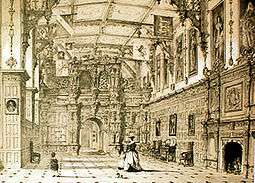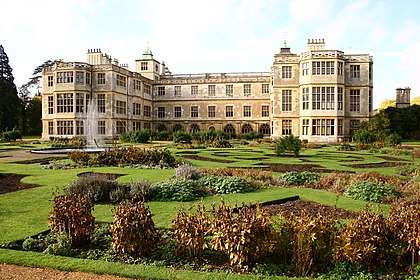Audley End House
| Audley End House | |
|---|---|
|
| |
| Type | Country house |
| Location | Littlebury |
| Coordinates | 52°01′13″N 0°13′11″E / 52.02039°N 0.21961°ECoordinates: 52°01′13″N 0°13′11″E / 52.02039°N 0.21961°E |
| OS grid reference | TL524381 |
| Area | Essex |
| Built | 17th Century |
| Architectural style(s) | Jacobean |
| Owner | English Heritage |
Listed Building – Grade I | |
| Official name: Audley End | |
| Designated | 1 Jul 1987 |
| Reference no. | 1000312 |
 Location of Audley End House in Essex | |
Audley End House (grid reference TL524381) is a largely early 17th-century country house outside Saffron Walden, Essex, England. It was once a prodigy house, a palace in all but name and renowned as one of the finest Jacobean houses in England. Audley End is now one-third of its original size, but is still large, with much to enjoy in its architectural features and varied collections. The house shares some similarities with Hatfield House, except that it is stone-clad as opposed to brick.[1] It is currently in the stewardship of English Heritage and long remained the family seat of the Lords Braybrooke.[2]
Recently the house and grounds have been used in popular television shows. During 2017, scenes were filmed at Audley End for Trust produced by Danny Boyle and based on the life of John Paul Getty III.[3] On 7 September 2018, scenes were shot for The Crown.[4]
Audley End railway station is named after the house.
History
Audley End was the site of Walden Abbey, a Benedictine monastery that was granted to the Lord Chancellor Sir Thomas Audley in 1538 by Henry VIII. The abbey was converted to a domestic house for him and was known as Audley Inn. It was demolished by his grandson, Thomas Howard (Lord Howard de Walden,[1] 1st Earl of Suffolk, fourth creation, and Lord Treasurer), and a much grander mansion was built, primarily for entertaining the king, James I.
The layout reflects the processional route of the king and queen, each having their own suite of rooms. It is reputed that Thomas Howard told King James he had spent some £200,000 creating this grand house, and it may be that the king had unwittingly contributed. In 1619, Suffolk and his wife were found guilty of embezzlement and sent to the Tower of London but a huge fine secured their release. Suffolk died in disgrace at Audley End in 1626.
At this time, the house was on the scale of a great royal palace, and became one when Charles II bought it in 1668 for £50,000[2] for use as a home when attending the races at Newmarket. It was returned to the Suffolks in 1701.
Over the next century Sir John Vanbrugh was commissioned to work on the site and parts of the house were gradually demolished[1] until it was reduced to its current size. The main structure has remained little altered since the main front court was demolished in 1708 and the east wing came down in 1753.

Sir John Griffin, fourth Baron Howard de Walden and first Baron Braybrooke, introduced sweeping changes before he died in 1797. In 1762, he commissioned Capability Brown to landscape the parkland, and Robert Adam to design new reception rooms on the house's ground floor in the neoclassical style of the 18th century with a formal grandeur.
Richard Griffin, 3rd Baron Braybrooke, who inherited house and title in 1825, installed most of the house's huge picture collection, filled the rooms with furnishings, and reinstated something of the original Jacobean feel to the state rooms.
Audley End was offered to the government during the Dunkirk evacuation but the offer was declined due to its lack of facilities.[5] It was requisitioned in March 1941[5] and used as a camp by a small number of units before being turned over to the Special Operations Executive. The SOE used the house as a general holding camp[6] before using it for its Polish branch. Designated Special Training School 43 (STS 43) it was a base for the Cichociemni. A memorial to the 108 Poles who died in the service stands in the main drive. After the war, the ninth Lord Braybrooke resumed possession, and in 1948 the house was sold to the Ministry of Works, the predecessor of English Heritage.
Gardens and grounds
The Capability Brown parkland includes many of the neo-classical monuments, although some are not in the care of English Heritage. The grounds are divided by the River Granta, which is crossed by several ornate bridges one of which features on the back cover of the BBC Gardeners' World Through the Years book,[7] and a main road which follows the route of a Roman road.
With help from an 1877 garden plan and William Cresswell's journal from 1874,[7] the walled kitchen garden was restored by Garden Organic in 1999 from an overgrown, semi-derelict state. It now looks as it would have done in late Victorian times; full of vegetables, fruits, herbs and flowers which have been supplied to the Dorchester Hotel.[7] It now boasts 120 apple, 60 pear and 40 tomato varieties.[8]

 Audley End in 1880
Audley End in 1880 The garden front
The garden front
Paintings
The house contains paintings by Canaletto,[9] Jan Asselijn, Jan Brueghel the Younger and Giovanni Battista Cipriani.[10]
References
- 1 2 3 Hadfield, J. (1970). The Shell Guide to England. London: Michael Joseph.
- 1 2 "History of Audley End House and Gardens". English Heritage. Retrieved 2017-11-18.
- ↑ "BBC - Trust - Media Centre". www.bbc.co.uk. Retrieved 2018-09-12.
- ↑ "TVs Crown at Audley End". Walden Local. 2018-09-12.
- 1 2 Valentine 2004, pp. 55-56.
- ↑ Valentine 2004, p. 66.
- 1 2 3 Search, Gay (2003). BBC Gardeners' World Through the years. London: Carlton Books Limited. ISBN 1-84442-416-2.
- ↑ "Blue Peter - Audley End House and Gardens". Retrieved 2018-09-12.
- ↑ "Audley End Collection". English Heritage. Retrieved 2017-11-18.
- ↑ Anon 2006, p. 220.
- Anon (2006). Oil paintings in public ownership in Essex. London: the Public Catalogue Foundation. ISBN 1-904931-14-6.
- Roger, Turner (1999). Capability Brown and the Eighteenth-century English Landscape (2nd ed.). Chichester: Phillimore. pp. 92–93. ISBN 978-1-86077-114-9.
- Valentine, Ian (2004). Station 43 Audley End House and SOE's Polish Section. Sutton Publishing Ltd. ISBN 0-7509-3708-4.
External links
| Wikimedia Commons has media related to Audley End House. |
- Audley End Information at English Heritage
- Friends of Audley End Volunteer group supporting the house
- 'Four centuries of change in a historic country house' on Google Arts & Culture